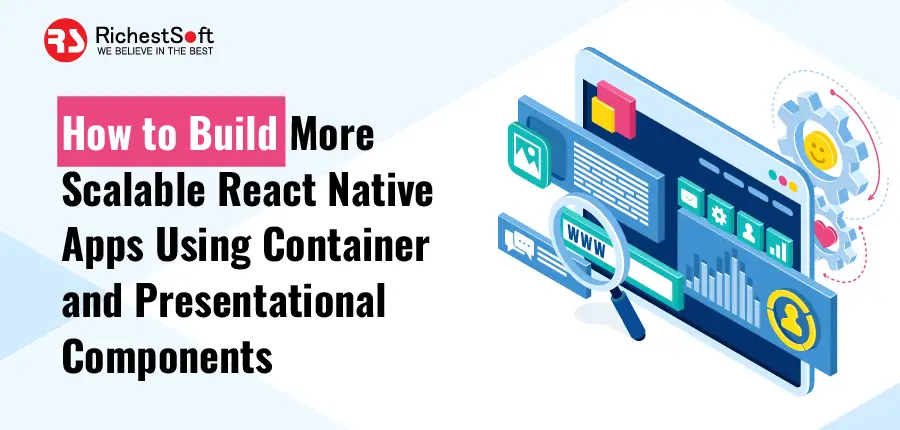In the world of mobile app development, React Native has become one of the most popular frameworks due to its ability to create high-performance and cross-platform applications. However, as the complexity of an app increases, managing its components can become challenging. That’s where container and presentational components come in.
The mobile app industry is growing with the increasing number of smartphone users worldwide, surpassing 6.3 billion. The use of mobile applications and the adoption of smartphones are consistently increasing, and there is no signal of a slowdown shortly.
This blog will explore React Native apps with the container and presentational components. We will discuss the benefits of using this architecture and how it can improve the performance and maintainability of your app.
Introduction to React Native App
React Native is an open-source mobile app development framework developed by Meta (Facebook). It allows react native app developers to build cross-platform applications using JavaScript, allowing react native apps to work on both iOS & Android devices. React Native provides a set of components, APIs, and features that will enable developers to build rich and interactive user experiences for their mobile apps.
Also, React Native delivers efficient performance, allowing apps to run smoothly on all devices. With its broad range of features and flexibility, React Native is fast becoming the go-to framework for developing mobile applications.
What are Container and Presentational Components?
Have you ever wondered how to create beautiful and interactive React Native apps? It all starts with understanding the differences between container and presentational components. Container components provide data and logic, while presentational components represent presentation logic.
Container Components
Container components provide data and logic to presentational components, allowing them to receive and render data effectively. They also manage the application state and provide information for the presentation layer. This means container components are ‘smart’ components connected to the Redux store and can access its data.
Presentational Components
Presentational components, on the other hand, are solely responsible for the UI and rendering of data. They are ‘dumb’ components and do not have access to the application’s state. This separation of concerns allows developers to create complex UIs using React Native.
Finally, container and presentational components produce powerful and interactive React Native apps. Understanding their differences and how they interact is essential to creating beautiful and intuitive user experiences.
Benefits of Using Container and Presentational Components
Presentational and Container components are among the most valuable and famous approaches in React Native apps. This practice splits the data logic from the view logic and helps developers build reusable components. The benefit of using this approach can be seen in many aspects.
Firstly, Presentational and Container components are easy to read and maintain. Since the view logic is separated from the data logic, it is easier to make changes and decrease the need for rewriting big blocks of code. This ensures that the code is organized and easy to read.
Secondly, this approach allows for better re-usability of code. Since the view and data logic are split, the same components can be used in multiple places without writing additional code. This helps decrease the time and resources needed to build a React Native app.
Thirdly, the Presentational and Container components can increase the app’s performance. Splitting the view and data logic will make the app more efficient and use fewer resources. This helps to enrich the overall user experience.
Using Presentational and Container components in React Native Apps can provide various benefits. It makes the code more comfortable to read and maintain, offers better code reusability, and helps enhance the app’s performance. These advantages make this practice an indispensable part of any React Native App.
Use of Containers and Presentational Components in React Native App
Container and Presentational components are prevalent in React Native development to create scalable and maintainable code. The container component manages the application’s state, handles any business logic, and passes the necessary data to the presentational components. The presentational component, on the other hand, focuses solely on rendering the UI and receiving the essential data from the container component.
To use this pattern in React Native, it is essential first to identify the areas of the application that require state management and the areas that only require UI rendering. Once the separation of concerns has been established, the next step is to create the necessary container and presentational components. When creating the container component, it is essential to define the state variables and the methods that will handle any updates to the state. The presentational component can then be created with the necessary props and UI elements.
Passing data between the container and presentational components can be achieved by explicitly defining props in the presentational component and passing them down from the container component. This approach ensures the code is easy to read and avoids unnecessary re-renders.
Using container and presentational components in React Native app development can lead to scalable and maintainable code. It is essential to identify the areas of the application that require state management and separation of concerns, create the necessary components, and pass data explicitly between the container and presentational components.
Following these best practices allows app developers to make efficient, high-quality code to build React Native App.
Best Techniques for Implementing Container and Presentational Components
Container and presentational components are popular in modern web development to separate concerns and improve code maintainability.
However, implementing this pattern can only be challenging with following best practices.
✔︎ It is essential to ensure that container components only handle state management and business logic, while presentational components only focus on rendering UI elements. This separation of concerns enables easy testing and reusability of components.
✔︎ Passing props from container to presentational components should be explicitly done to enhance code clarity and avoid unnecessary re-renders.
✔︎ Using a single source of truth, such as Redux, to manage the application state is recommended to ensure consistency and avoid conflicts between components.
✔︎ Utilizing React hooks, such as useState and useEffect, to manage component state and lifecycle methods is a best practice that improves code readability and maintainability.
Implementing container and presentational components can be a powerful technique to enhance code quality, and following these best practices can make it a straightforward and effective process.
How to Structure an App with Container and Presentational Components
When developing an application, it is essential to separate concerns between the user interface (UI) and the logic that drives it. One way to achieve this is by using a container and presentational components pattern. In this pattern, the container components handle the logic and data manipulation, while the presentational components focus solely on the visual representation of the data.
To implement this pattern, identify the data and state management components. These are the container components. They should be responsible for fetching data, processing it, and passing it down to the presentational components. The presentational components should only be concerned with displaying the data visually appealingly.
Separating concerns in this way makes it easier to maintain and update the application as it grows. The container components can be reused across different application parts, while the presentational components can be swapped or modified without affecting the underlying logic.
Additionally, the code becomes easier to understand and debug since each component has a clear responsibility.
The container and presentational components pattern is a powerful technique for structuring applications that rely on data and state management. It helps separate concerns and separate responsibilities between different application parts. As such, it is an essential technique for any developer looking to build scalable, maintainable applications.
Examples of Apps Using Container and Presentational Components
Container and Presentational Components are famous in React Native app development because they help developers to create reusable and modular code.
There are many examples of apps that use these components to significant effect.
Airbnb App:- Airbnb app uses Container and Presentational Components to create a visually stunning and user-friendly interface.
Starbucks App:- Starbucks app uses Container Components to manage data and state and Presentational Components to display information to the user.
Facebook App:- Facebook app uses Container and Presentational Components extensively, with Container Components managing complex logic and data flows and Presentational Components providing a clear and concise user interface.
These examples show how Container and Presentational Components can be used to create high-performance apps that are both scalable and maintainable. By separating logic and presentation, developers can create easier-to-maintain and update code over time, making it a popular choice among React Native developers.
RichestSoft is the Best Choice for React Native App Development Company
- RichestSoft is a top React Native App Development Company with highly skilled developers.
- Their expertise in React Native guarantees that every mobile app project is delivered on time and within budget.
- They deliver a full range of services, including mobile app design, development, testing, maintenance, and marketing.
- RichestSoft has experience working on various mobile app projects across different industries.
- Their team of project managers and developers continually communicate with clients, providing regular updates on the project’s progress and handling any concerns or questions that may arise.
- They offer post-deployment support to guarantee that the application continues to meet the client’s requirements.
Frequently Asked Questions
Q1: What are container and presentational components in React Native?
Ans: Container and presentational components are used in React Native development to separate concerns and create scalable code. The container component manages the application’s state, handles any business logic, and passes the necessary data to the presentational components. The presentational component, on the other hand, focuses solely on rendering the UI and receiving the required data from the container component.
Q2: Why use container and presentational components in React Native development?
Ans: Using container and presentational components in React Native development can lead to scalable and maintainable code. Separating concerns ensures that the code is easier to read and maintain, making reusing components throughout the application more comfortable.
Q3: How do I create a container and presentational components in React Native?
Ans: To create a container and presentational components in React Native, you first need to identify the areas of the application that require state management and the places that only require UI rendering. Once you have recognized these areas, you can create the necessary components. When creating the container component, define the state variables and the methods that will handle any updates to the state. The presentational component can then be made with props and UI elements.
Q4: How do I pass data between the container and presentational components in React Native?
Ans: Data can be passed between the container and presentational components in React Native by explicitly defining props in the presentational component and passing them down from the container component. This approach ensures the code is easy to read and avoids unnecessary re-renders.
Q5: What are some best practices for using container and presentational components in React Native?
Ans: Some best practices for using container and presentational components in React Native include separating concerns, passing data explicitly, using a single source of truth for managing application state, and utilizing React hooks to manage component state and lifecycle methods.
Conclusion
Overall, React Native apps with container, and presentational components provide a great way to organize code and make development more efficient. Not only does this approach help you quickly find the source of any issue or bug in your app, but makes it easier for developers to add new features without having to rewrite existing code. With the proper setup, creating React Native apps can be an enriching experience!







Leave a Reply